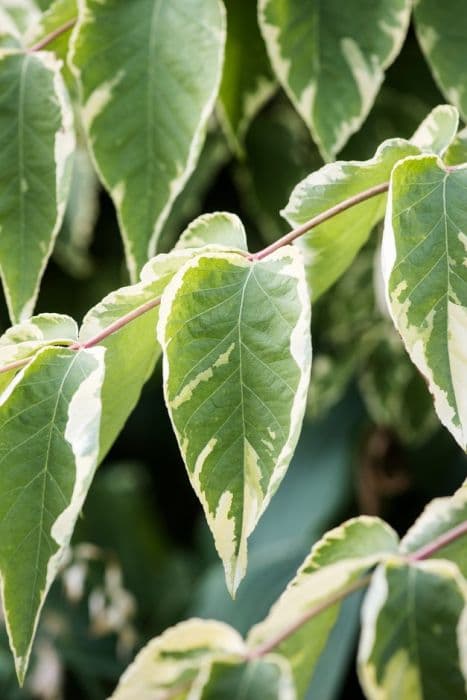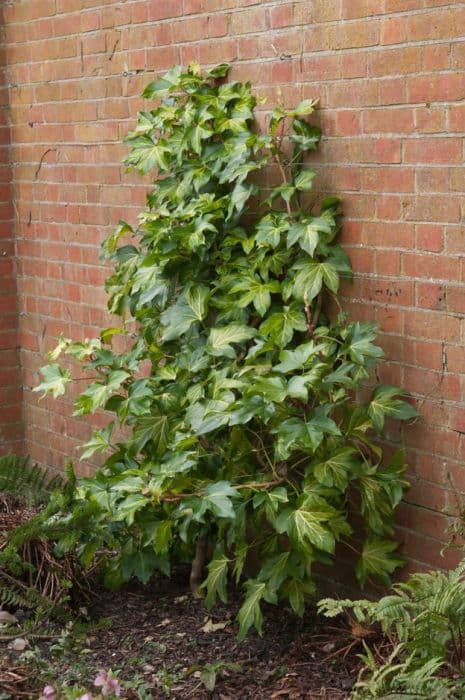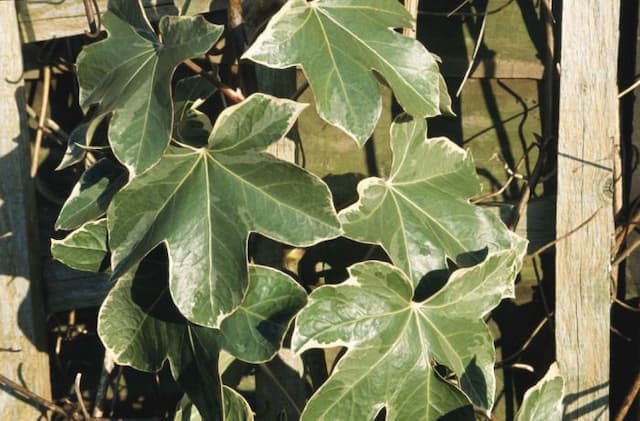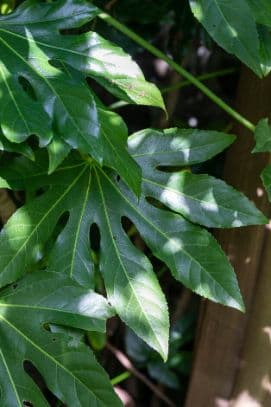Persian ivy Hedera colchica

ABOUT
The plant commonly known as Persian ivy has a robust and plush appearance, with broad, leathery leaves that are heart-shaped at the base and often pointy at the ends. The foliage provides a dense canopy of lush green, with leaves that can display a variety of colors, from deep green to variegated patterns of cream, white, or yellow, depending on the variety. It has a vigorous growth habit, creating a lush tapestry over the surfaces it climbs. During the autumn months, this plant can produce small, inconspicuous flowers, which are followed by spherical berries that might be a draw for local birdlife. These berries frequently display a dark hue when ripe. Although known for its climbing ability, Persian ivy can also spread across the ground, forming a thick mat of leaves, and is sometimes used as a ground cover. The plant's overall appearance can be described as both elegant and robust, with a cascading habit that adds to its ornamental appeal.
About this plant
 Names
NamesFamily
Araliaceae
Synonyms
Colchis Ivy, Persian Ivy, Sulphur Heart
Common names
Hedera colchica K.Koch.
 Toxicity
ToxicityTo humans
Persian ivy (Hedera colchica) contains saponins and other compounds that can be toxic when ingested. Eating leaves or berries of the Persian ivy may cause gastrointestinal symptoms such as vomiting, diarrhea, and abdominal pain. Additionally, the plant may provoke a hypersalivation response. In severe cases, it could potentially lead to more serious symptoms like difficulty in breathing or even coma, especially if large quantities are consumed.
To pets
Persian ivy (Hedera colchica) is also toxic to pets. If a pet ingests the leaves or berries, they could experience symptoms including vomiting, diarrhea, excessive drooling, and abdominal pain. In severe cases, ingestion can result in more critical conditions like breathing difficulties, muscle spasms, or coma. Immediate veterinary attention is advisable if ingestion is suspected.
 Characteristics
CharacteristicsLife cycle
Perennials
Foliage type
Evergreen
Color of leaves
Green
Height
30 feet (9 meters)
Spread
50 feet (15 meters)
Plant type
Climber
Hardiness zones
7
Native area
Caucasus
Benefits
 General Benefits
General Benefits- Ornamental Value: The Persian ivy adds aesthetic appeal to gardens, walls, and fences due to its lush, evergreen foliage.
- Growth Habit: Its vigorous climbing habit makes it useful for covering unsightly features and providing greenery in urban environments.
- Erosion Control: Persian ivy can help stabilize soil on slopes, preventing erosion through its dense root system.
- Habitat for Wildlife: It offers shelter and breeding spaces for birds and insects within its dense leaves.
- Low Maintenance: Once established, it requires minimal care, making it suitable for low-maintenance gardening.
- Tolerance: It is tolerant to a range of soil types, exposure (including shaded areas), and can withstand urban pollution.
- Year-Round Interest: As an evergreen, Persian ivy provides constant greenery throughout all seasons.
- Variety: There are several cultivars available with different variegation and leaf shapes, providing options for garden design.
 Medical Properties
Medical Properties- This plant is not used for medical purposes.
 Air-purifying Qualities
Air-purifying QualitiesThis plant is not specifically known for air purifying qualities.
 Other Uses
Other Uses- Hedera colchica, commonly known as Persian Ivy, can be used as a cooling agent in buildings by covering walls, due to its dense foliage creating a barrier against heat.
- Persian Ivy can be fashioned into living curtains for outdoor pavilions or pergolas, offering a natural and aesthetic shade option.
- This plant's robust vines can be trained over wire frames to create topiary art, offering gardeners a creative outlet for shaping green sculptures.
- Persian Ivy, due to its aggressive growth, can be used in erosion control to stabilize soil on slopes and prevent landslides.
- The vines of Persian Ivy can be utilized in crafting and basketry, with young, pliable stems woven into decorative or functional items.
- For privacy screens, Persian Ivy can be grown on trellises or fences to create a living barrier that is both private and attractive.
- In large aquarium setups, trimmed Persian Ivy can be used outside the tank, draping around it to create a naturalistic backdrop and hiding technical equipment.
- Persian Ivy serves as a refuge and a breeding ground for certain species of birds, supporting biodiversity in urban and garden environments.
- This ivy is sometimes used in fashion photography and set designs to add a touch of nature and lushness to the scenery.
- When dried and treated, Persian Ivy leaves can be used in decorative arrangements or as a part of natural craft materials for different DIY projects.
Interesting Facts
 Feng Shui
Feng ShuiThe Persian Ivy is not used in Feng Shui practice.
 Zodiac Sign Compitability
Zodiac Sign CompitabilityThe Persian Ivy is not used in astrology practice.
 Plant Symbolism
Plant Symbolism- Connection and Friendship: Hedera colchica, commonly known as Persian ivy, is often symbolic of strong bonds and friendships due to its clinging nature which reflects the idea of sticking together through various conditions.
- Eternity and Fidelity: With its evergreen leaves, Persian ivy represents enduring life and faithfulness, suggesting a commitment that lasts throughout all seasons of life.
- Protection: Persian ivy is thought to provide protection against negative energy and evil, mirroring ancient traditions where ivy would be used to ward off spirits.
- Survival and Resilience: Due to its vigorous growth habits and ability to thrive in difficult conditions, Persian ivy symbolizes perseverance and the ability to overcome challenges.
- Prosperity and Abundance: In some cultures, ivies like Persian ivy are seen as signs of abundance and good fortune, as their lush foliage spreads quickly and covers large areas.
 Water
WaterThe Persian ivy should be watered when the top inch of its soil feels dry to the touch, which typically means watering about once a week. However, the frequency will depend on the climate and humidity levels, with less frequent watering needed in high humidity and cooler temperatures. Use lukewarm water and water at the base of the plant to avoid wetting the foliage which can lead to fungal diseases. During the growth season in spring and summer, Persian ivy may need up to 1 gallon of water every week if it's planted outdoors, but always check the soil moisture level before watering.
 Light
LightPersian ivy thrives in partial to full shade, so the best spot for the plant is where it will receive filtered sunlight or dappled shade. Direct sunlight can scorch the leaves, especially during the hottest part of the day. An east-facing or north-facing location where the plant gets gentle morning light or late afternoon light is ideal for maintaining the vibrant color and health of the leaves.
 Temperature
TemperaturePersian ivy is hardy and can withstand a temperature range from about 30°F to a maximum of 80°F, but it grows best in temperatures between 50°F and 70°F. Extreme temperatures on either end can stress the plant, so provide a sheltered location if outdoor temperatures exceed these ranges. Indoors, maintain a comfortable room temperature, avoiding drafts and direct heat sources.
 Pruning
PruningPruning Persian ivy is primarily for maintaining shape and promoting denser growth. It should be pruned in late winter or early spring before new growth begins. Cut back any overgrown or unwanted vines to a set of leaves, which encourages branching. Additionally, removing dead or damaged foliage throughout the year helps to keep the plant healthy. Pruning can be done once a year or as necessary to control its size.
 Cleaning
CleaningAs needed
 Soil
SoilPersian Ivy thrives in a well-draining, loamy soil mix with a pH between 6.0 and 7.5. A blend of two parts peat or coir, one part perlite, and one part organic compost creates an ideal environment for its roots. Regular mulching helps retain moisture and keeps the nutrient levels optimal.
 Repotting
RepottingPersian Ivy should be repotted every two to three years or when the plant becomes root-bound. Larger pots promote growth, but ensure they have good drainage to prevent waterlogging. Spring is the best time to repot to minimize stress on the plant.
 Humidity & Misting
Humidity & MistingPersian Ivy prefers moderate to high humidity levels, ranging from 40% to 70%. To maintain optimal humidity, regularly mist the leaves, use a humidity tray, or place a humidifier nearby, especially during dry winter months or in arid climates.
 Suitable locations
Suitable locationsIndoor
Keep Persian Ivy in bright, indirect light with occasional misting.
Outdoor
Plant Persian Ivy in partial shade; water regularly.
Hardiness zone
6-9 USDA
 Life cycle
Life cycleHedera colchica, commonly known as Persian ivy, begins its life cycle as a seed, which upon germination in suitable moist and shaded conditions develops into a seedling. The seedling grows through a juvenile vegetative stage, characterized by lobed, heart-shaped leaves and a creeping growth habit, as it adheres to surfaces with aerial rootlets. As the plant matures, it enters the adult vegetative stage, where the leaves become unlobed and the stems grow thicker and woodier. Persian ivy then produces clusters of small, greenish-yellow flowers in the fall, which are attractive to pollinators. Following pollination, these flowers develop into small, blue-black berries that contain seeds, thus completing the reproductive cycle. These berries are dispersed by birds, which eat them and excrete the seeds to new locations, where they can germinate and start a new cycle.
 Propogation
PropogationPropogation time
Spring-early summer
Hedera colchica, commonly known as Persian ivy, is typically propagated through stem cuttings. This method is most popular due to its simplicity and effectiveness. To propagate Persian ivy using stem cuttings, one should select a healthy stem, preferably in spring or early summer when the plant is in an active growth phase. A cutting of about 4 to 6 inches (10 to 15 centimeters) long with several leaves is ideal. The bottom leaves are removed, and the cut end is dipped in rooting hormone powder to encourage root development. The cutting is then planted in a pot filled with a well-draining soil mix, ensuring at least one node is buried where roots can form. The pot should be placed in a warm, bright area but out of direct sunlight and kept moist until new growth indicates that the cutting has rooted, which typically takes a few weeks.









